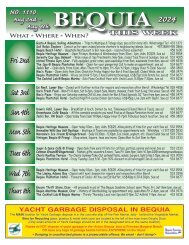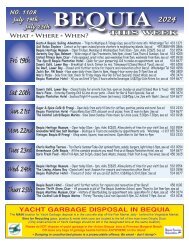Caribbean Compass Yachting Magazine - December 2020
Welcome to Caribbean Compass, the most widely-read boating publication in the Caribbean! THE MOST NEWS YOU CAN USE - feature articles on cruising destinations, regattas, environment, events...
Welcome to Caribbean Compass, the most widely-read boating publication in the Caribbean! THE MOST NEWS YOU CAN USE - feature articles on cruising destinations, regattas, environment, events...
You also want an ePaper? Increase the reach of your titles
YUMPU automatically turns print PDFs into web optimized ePapers that Google loves.
DECEMBER <strong>2020</strong> CARIBBEAN COMPASS PAGE 18<br />
I<br />
live in Puerto Rico, and that’s a draw for<br />
visitors. Mine come mostly from the US<br />
northeast, where I used to live. The<br />
adventurous visitors even accept my<br />
invitation to sail on my 35-foot sloop, Second Wind.<br />
The promise is the lure of the <strong>Caribbean</strong>: turquoise<br />
blue sailing water, ice-cold cervezas, beautiful small<br />
islands with fun open-air beach bars, and the best<br />
burger in the world at Lazy Jack’s in Vieques, one of<br />
the Spanish Virgin Islands southeast of Puerto Rico.<br />
What I don’t promise are skies empty of rainsqualls,<br />
terrifying thunderstorms and lightning. Well, those are<br />
kind of implied.<br />
My good friend and former Boston neighbor, Mike,<br />
arranged a first-time visit after the NOAA five-day<br />
forecast showed no developing conditions during<br />
hurricane season. Two days after his arrival and<br />
provisioned for four days, we left Fajardo for a dueeast<br />
sail to Culebrita, another of the Spanish Virgins,<br />
a 22-nautical-mile sail from Puerto Rico. Tropical<br />
storms that moved a safe distance north and south of<br />
Puerto Rico left a rare northern wind, a perfect<br />
opportunity for a straight beam reach. I promised Mike<br />
a gorgeous, placid horseshoe bay called Tortuga Beach<br />
at Culebrita. I had sailed to Culebra several times, but<br />
never to Culebrita (Little Culebra), so it would be a<br />
shared new sailing adventure.<br />
Mike is a motorboater, meaning he has good<br />
transferable experience for sailing. He wanted the helm<br />
— great for me, since it allowed me to trim the sails and<br />
find the most direct course. Salmon filets marinated in<br />
soy and teriyaki sauce and ginger would be our first<br />
night’s dinner, since there are no facilities on Culebrita,<br />
just an old lighthouse that I was eager to see. Mike could<br />
savor the best burger in the world after we left Culebrita.<br />
Like most sailors, I have more than one weather app,<br />
four in fact, and I checked them all before we left. Each<br />
showed not much chop, but not much wind either.<br />
Nothing to worry about. Or so I thought.<br />
Late in the afternoon, we took a left past Culebra<br />
and into the channel between the two islands and we<br />
started sailing north. The channel is dramatic, green<br />
of islands, blue of sea, and beautiful. Culebra was on<br />
our port, Culebrita on our starboard, and rocks in the<br />
distance rose out of the water forming small and tall<br />
islands. The channel does have some challenges for<br />
the first-time navigator. Where we would hook a right<br />
to sail into the horseshoe bay of Culebrita would not<br />
become clear until we sailed farther north.<br />
The skies began to darken but it was late afternoon,<br />
so it was nothing alarming. As we approached, we saw<br />
the narrow opening between two small cayos and we<br />
bore off to starboard. We could see Tortuga Beach, but<br />
it was not the placid, idyllic turquoise bay we expected.<br />
Huge dark waves rolled towards the beach.<br />
“I just saw lightning,” Mike exclaimed.<br />
I could not worry about lightning, I needed to figure<br />
out how to get over those rollers and into the bay, or if<br />
we should even try. We had few other options, since it<br />
was getting dark and other anchorages were not close.<br />
One long rolling wave after another guarded the<br />
entrance to the bay. I trimmed the sails and Mike fired<br />
up the engine. Near the right side of the beach I saw a<br />
mast. “There is a catamaran in there,” I said to Mike. Its<br />
presence gave us comfort that we could sail in. Of course,<br />
we had no idea in what sailing conditions the cat arrived.<br />
LIGHTNING<br />
STRIKES —<br />
NEARLY<br />
by Damian LaPlaca<br />
We anchored behind the 50-foot catamaran<br />
and sat dazed.<br />
The radar app showed that one of several storms in<br />
the immediate area would soon be directly overhead.<br />
NOOA<br />
Mike motorsailed perpendicular to the rolling wave.<br />
Our strategy was to sail in at the middle, where it<br />
appeared the wave was the smallest. As we approached,<br />
I guessed the largest height of the wave, closest to the<br />
edges of each side of the bay, was near ten feet. I had<br />
recently sailed downwind from St. Thomas to Culebra<br />
with 25 knots of Christmas Winds and following seas,<br />
and surfed down troughs of six- to eight-foot waves,<br />
but I had never sailed over a single huge roller like<br />
this, moving in the same direction as the boat. I could<br />
not calculate the danger or even the wisdom of making<br />
the approach. If we miscalculated and took an angle a<br />
breaking wave could broach the boat.<br />
As we neared, I looked to port and could see the big<br />
wave up close and too personal. I hollered to Mike to<br />
veer off to port. Mike turned hard and we did a 180. I<br />
did not look forward to sailing to another anchorage in<br />
the dark. We approached again.<br />
We timed the wave as it broke and Mike smoothly<br />
sailed into the bay with barely a bounce. We looked<br />
back at the next roller forming behind us and<br />
congratulated our success, though smaller rolling<br />
waves followed us. We anchored behind the 50-foot<br />
catamaran and sat dazed before we enjoyed our first<br />
beer. Mike researched lightning on his phone. Since<br />
we could not safely cook salmon on my stern grill cold<br />
roasted chicken below was our first night’s dinner.<br />
We talked of what to do in the event of a lightning<br />
strike. The wind kept us parallel to the beach and<br />
Second Wind rocked laterally with the oncoming<br />
waves. Although we stayed on our cushions in our<br />
respective cabins we were in for a sleepless night.<br />
Shortly before 4:00am I woke to the booming sound<br />
of thunder. I looked up through the overhead hatch<br />
window to see bursts of brilliant white lightning<br />
followed by staccato white flashes. I opened one of my<br />
radar apps and saw that one of several storms in the<br />
immediate area would soon be directly overhead. My<br />
heart rate increased. Given the storm’s northerly<br />
direction, thunder and lightning to starboard meant<br />
the storm was coming over us. Bursts to port meant<br />
that part of the storm had passed over.<br />
We endured the electrical storm for almost three<br />
hours during which we were sure we were going to get<br />
hit. The sound of thunder is much greater on a<br />
sailboat than in the comfort of an enclosed house. In<br />
each moment I thought the worst had passed, lightning<br />
suddenly flashed overhead, and when thunder crashed<br />
less than a second after, I became very concerned.<br />
Anything can happen when lightning hits a sailboat. It<br />
can burst a hole and sink it, it can destroy electronics,<br />
it can kill crewmembers.<br />
In the morning Mike laughed, a reversal of his<br />
concern the night before. And why not? We’d survived<br />
an intense lightning storm on a sailboat. The catamaran<br />
was safe, too, and still had its anchor light on. When<br />
we were sure the storm had passed, we raised the<br />
mainsail for Vieques, this time fighting the oncoming<br />
roller at the bay’s entrance. Our timing was not as<br />
precise and we slapped hard against the wave.<br />
We had three more days of easy, drama-free sailing.<br />
Perhaps the most difficult experience was not waiting<br />
out the lightning storm or negotiating the ten-foot<br />
rollers. Lazy Jack’s was serving only fried food! Oh<br />
well, Mike will have to return for another sail and<br />
another try for the best burger in the world. But I<br />
promise nothing.<br />
LIGHTNING<br />
TIPS<br />
I have read much more about safety measures to<br />
take during a lightning storm. Disconnect electronics<br />
to the greatest extent possible. Place small electronics<br />
in an oven or microwave. Ground the rig by<br />
attaching chain to the base of the upper shrouds<br />
and letting it hang in the water. Make fire<br />
extinguishers temporarily more accessible. Get your<br />
rubber dinghy ready for a quick exit. Keep your<br />
handheld VHF handy. Always keep paper charts on<br />
the boat in the event electronic charts get fried.<br />
These are just a few of the safety measures available<br />
to most sailboats. Check the weather more often<br />
than just in the morning. And always have a Plan B<br />
anchorage or mooring when arriving in a new<br />
destination at dusk.

















